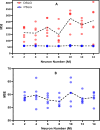Utilizing machine learning to predict MRI signal outputs from iron oxide nanoparticles through the PSLG algorithm
- PMID: 40670416
- PMCID: PMC12267469
- DOI: 10.1038/s41598-025-01994-0
Utilizing machine learning to predict MRI signal outputs from iron oxide nanoparticles through the PSLG algorithm
Abstract
In this research, we predict the output signal generated by iron oxide-based nanoparticles in Magnetic Resonance Imaging (MRI) using the physical properties of the nanoparticles and the MRI machine. The parameters considered include the size of the magnetic core of the nanoparticles, their magnetic saturation (Ms), the concentration of the nanoparticles (C), and the magnetic field (MF) strength of the MRI device. These parameters serve as input variables for the model, while the relaxation rate R2 (s-1) is taken as the output variable. To develop this model, we employed a machine learning approach based on a neural network known as SA-LOOCV-GRBF (SLG). In this study, we compared two different random selection patterns: SLG disperse random selection (DSLG) and SLG parallel random selection (PSLG). The sensitivity to neuron number in the hidden layers for DSLG was more pronounced compared to the PSLG pattern, and the mean square error (MSE) was calculated for this evaluation. It appears that the PSLG method demonstrated strong performance while maintaining less sensitivity to increasing neuron numbers. Consequently, the new pattern, PSLG, was selected for predicting MRI behavior.
Keywords: Iron oxide nanoparticles; Machine learning; Magnetic resonance imaging (MRI); RBF neural network.
© 2025. The Author(s).
Conflict of interest statement
Declarations. Competing interests: The authors declare no competing interests.
Figures









References
-
- Obaido, G. et al. Supervised machine learning in drug discovery and development: Algorithms, applications, challenges, and prospects. Mach. Learn. Appl.17, 100576 (2024).
LinkOut - more resources
Full Text Sources

